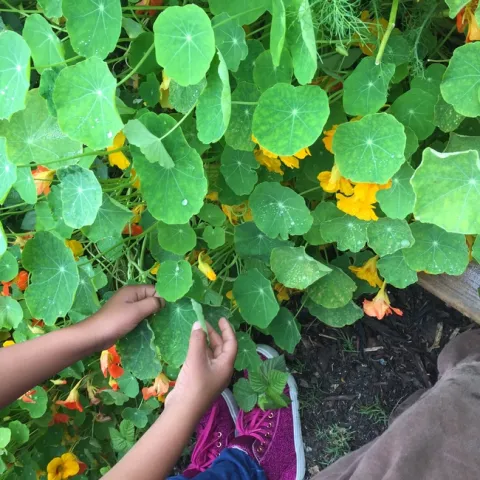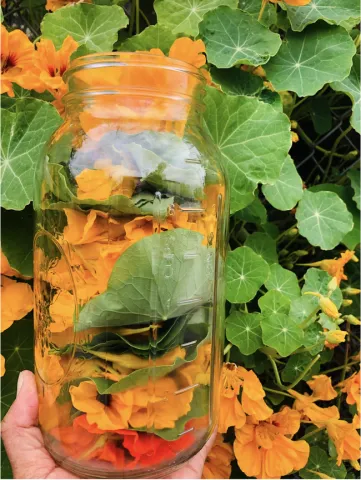
These jeweled toned beauties are wonderful in the garden.
Nasturtiums are quite easy to grow and usually planted in the Spring after the last frost has passed. I have seen Nasturtiums begin to grow from the previous season as early as January. Many believe they are perennials when in fact, they are annuals. There are so many varieties of Nasturtiums, my favorite being the trailing variety which I love to see climb walls, trellises, and fences. If you are without space, or have minimum garden space, Nasturtiums can be planted in a pot. Hanging pots are great for trailing Nasturtiums. They look amazing when they spill over the edges.
They grow full, flower vibrantly during the spring and early summer with jeweled tone colors, and have bright green leaves reminiscent of lily pads. Butterflies, bees and hummingbirds love this plant.
Nasturtiums grow best from seed sown directly in the soil. I have also propagated from cuttings that performed well in the garden.
Many gardeners plant Nasturtiums in the garden as a trap crop to draw away aphids from neighboring crops. Try planting Nasturtium next to cucumbers, kale and tomatoes for healthy company and natural pest control.
CARE
Nasturtiums do not need to be fertilized. In fact, fertilizer can produce more leaves than flowers. Developing a good weekly watering system should be sufficient. These beautiful blooms love full sun exposure and show tolerance for shade and some drought, although lack of water will cause flowers to wilt. When it comes to maintenance, trailing varieties can benefit from a light pruning and removal of yellowing leaves. Add the fresh green leaves to salad or enjoy a few pieces prior to discarding.
HARVEST

All parts of the nasturtium plant can be harvested for culinary use. The best time to harvest leaves is when the plant is young - approximately 6 inches tall. Harvest flowers just as they open. You can cut flowers and stems together. Collect the green seed pods when they are just over 1/4" inch in diameter. These can be used for pickling. Discard small, hardened pods.
Nasturtium seeds for future planting are easy to collect. The plants often self-sow. When they self-sow, the seeds fall to the ground, making collecting a breeze. Seeds will be a mixture of small and mature green and brown pods. I save the green pods for culinary use and collect the brown pods to grow for next season. Discard small, immature seeds, as they do not have a good germination success rate.
How to enjoy your Nasturtiums Leaves, Flowers and Seed Pods

All parts of Nasturtium plants are edible. The leaves, flowers and green seeds are used in cooking. The spicy leaves and flowers can be used fresh in salads. The green seed pods, which have a zesty tangy peppery flavor, have become known as “Poor Man's Capers.” I enjoy them fresh. There are so many culinary uses for fresh or pickled parts of the nasturtium plant. I have shared a use below.
Nasturtium Pickled Capers: 1-1-1
1 Cup of firm green seed pods
1 Cup of White Vinegar or Apple Cider
1 teaspoon of Sea Salt
8 Peppercorns
*Add a drizzle of honey for a sweet & tangy taste. Alllow the mixture to sit for 20 minutes or longer. Enjoy. Refrigerate whatever is left!

